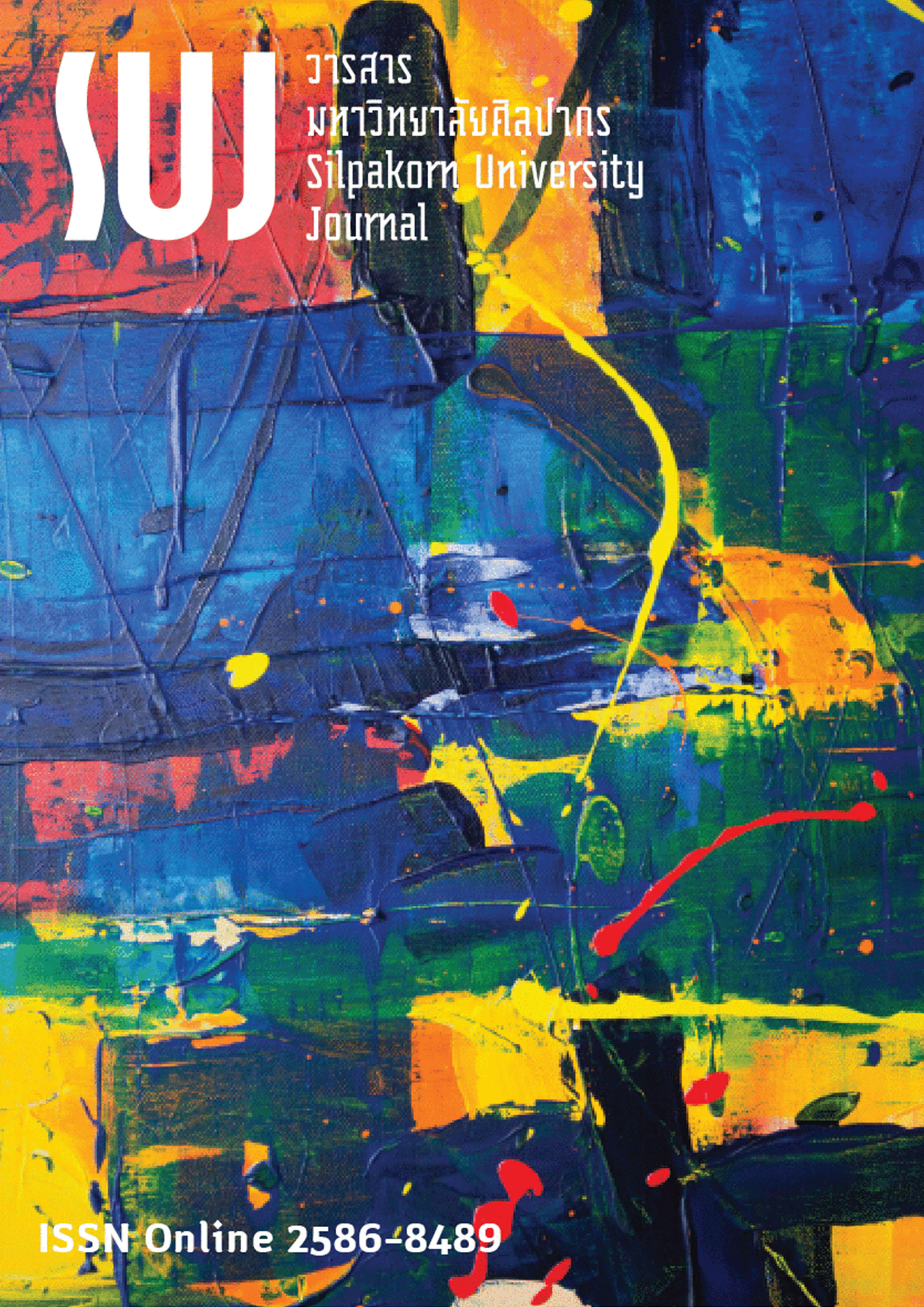การเปรียบเทียบปัจจัยการออกแบบสื่อโฆษณาดิจิทัลไซเนจที่ส่งผลต่อความสนใจ (The comparative study of factors concerning digital signage advertising to capture customers’ interest)
Main Article Content
Abstract
การวิจัยครั้งนี้จึงมีวัตถุประสงค์เพื่อศึกษาขนาดภาพสินค้า เวลาในการแสดงผล และเทคนิคการเปลี่ยนภาพของสื่อโฆษณาดิจิทัลไซเนจ โดยมีกลุ่มตัวอย่าง จำนวน 2 กลุ่ม ประกอบด้วย อายุระหว่าง 20-29 และ 30-39 ปี รวมทั้งสิ้น 100 คน ใช้วิธีการสุ่มกลุ่มตัวอย่างแบบเจาะจง ระเบียบวิธีวิจัยทำโดยออกแบบโครงสร้างสื่อโฆษณาดิจิทัลไซเนจ และทำการเปรียบเทียบความสนใจต่อขนาดภาพสินค้าของสื่อโฆษณาดิจิทัลไซเนจ จำนวน 4 ขนาด และเปรียบเทียบความสนใจต่อเวลาในการแสดงผล จำนวน 5 ช่วงเวลา และเทคนิคการเปลี่ยนภาพ จำนวน 3 รูปแบบ ผลการศึกษาพบว่า การแสดงภาพสินค้าที่มีขนาดร้อยละ 20 ของพื้นที่โฆษณาส่งผลต่อความสนใจของกลุ่มตัวอย่างมากที่สุดอย่างมีนัยสำคัญทางสถิติที่ระดับ (.05) ส่วนเวลาในการแสดงผลต่อภาพและเทคนิคการเปลี่ยนภาพของสื่อโฆษณาดิจิทัลไซเนจที่มีความสนใจมากที่สุด คือช่วงเวลา 10 วินาทีต่อภาพ และเทคนิคการเปลี่ยนภาพรูปแบบ cut on action เมื่อพิจารณาความสนใจแต่ละช่วงอายุ พบว่า ช่วงอายุที่ต่างกันส่งผลต่อความสนใจต่อสื่อโฆษณาดิจิทัลไซเนจในบางปัจจัย ผลการวิจัยสามารถประยุกต์ได้กับอุตสาหกรรมการออกแบบสื่อโฆษณาดิจิทัลในประเทศไทยที่มีสินค้าเกี่ยวกับอาหารและเครื่องดื่ม
This study aims to design the digital signage advertising media layout, and to compare customers’ interest to products’ sizes, presentation time of each image, and format for scene transition of the digital signage advertising media. One hundred volunteers were divided into two different groups—20-29 and 30-39 years of ages. The methodology was performed by designing digital signage advertising media layout and compare customers’ attention to 4 product image sizes of the digital signage advertising media. After that, five presentation periods of time and 3 formats of scene transition were compared and analyzed. The result showed that the product image size with 20% of the entire screen area most effectively attracts the volunteers, statistically significant (0.5). Moreover, as for the presentation duration for each image and the format of scene transition for digital signage advertising media, 10 seconds per image and the “cut on action” format for the scene transition were most effective. Regarding the age of customers, the study showed that differences in ages have some effects on the digital signage advertising. Importantly, the result of his research can be applied in designing advertisements or publicity on digital signage screen, especially the advertisement concerning food.
Downloads
Article Details

This work is licensed under a Creative Commons Attribution-NonCommercial-NoDerivatives 4.0 International License.
References
Brown College. (2015). Tips for Designing and Managing Digital Signage Systems. Presented by HB Communications in Collaboration with Brown University. [online]. Retrieved November 2, 2020 from https://bit.ly/3Ann0hE
Burke, R. R. (2009). Behavioral Effects of Digital Signage. Journal of Advertising Research, 49(2): 180-185.
Chandraramya, L., & Thammarisiroj, W. (2021). User Interface Design for Smart Farms-Controlled Application Case Study on a Flower Farm. Silpakorn University Journal, 41(4): 65-76.
Codispoti, M., & De Cesarei, A. (2007). Arousal and Attention:Picture Size and Emotional Reactions. Psychophysiology, 44(5): 680-686.
Davies, N., Clinch, S., & Alt, F. (2014). Pervasive Displays: Understanding the Future of Digital Signage. Synthesis Lectures on Mobile and Pervasive Computing, 8(1): 1-128.
Dennis, C., Newman, A., Michon, R., Brakus, J. J., & Wright, L. T. (2010). The Mediating Effects of Perception and Emotion: Digital Signage in Mall Atmospherics. Journal of Retailing and Consumer Services, 17(3): 205-215.
Gilder, Ch. (2016). 8 steps to successful digital signage content. [Online]. Retrieved May 24, 2019 from https://bit.ly/2YCzo0r
Grewal, D., Motyka, S., & Levy, M. (2018). The Evolution and Future of Retailing and Retailing Education. Journal of Marketing Education, 40(1): 85-93.
Ijaz, M. F., Tao, W., Rhee, J., Kang, Y. S., & Alfian, G. (2016). Efficient digital signage-based Online store layout: An experimental study. Sustainability, 8(6): 1-20.
Ithaca College. (2016). Digital Sign 101 Learning the Content Manager Express (CMX) Web App Enterprise Digital Signage Training. Exterity. [Online]. Retrieved March 18, 2021 from https://bit.ly/3AN5pkl
Jarukasetwit, Naipaporn. (2018). The Study on Service Utilization Behavior, Attitude, Approach and Development of Digital Signage (การศึกษาพฤติกรรมการใช้บริการ ทัศนคติ แนวทางและการพัฒนาสื่อประชาสัมพันธ์ผ่านจอภาพเพื่อการสื่อสาร). Master’s dissertation, Chulalongkorn Universty, Bangkok, Thailand.
Kaewkaen, Pratchaya. (2012). Attention Process and The Modified Knowledge for Cognitive Science Research (กระบวนการความสนใจและการประยุกต์สำหรับการวิจัยทางวิทยาการปัญญา). Research Methodology & Cognitive Science, 10(1): 1-10.
Kirkorian, H. L., & Anderson, D. R. (2017). Anticipatory Eye Movements While Watching Continuous Action Across Shots in Video Sequences: A Developmental Study. Child Development, 88(4): 1284-1301.
Mgr Online. (2021). The world’s digital screen surpasses 200 billion. “Samsung” has grown to receive the transformation. (จอดิจิทัลโลกทะลุ 2 แสนล้าน “ซัมซุง” โตรับทรานส์ฟอร์มฯ) [Online]. Retrieved June 13, 2021 from https://bit.ly/3DAn2UV
Newman, A., Dennis, C., & Zaman, S. (2006). Marketing Images and Consumers’ Experiences in Selling Environments. Marketing Management Journal, 20(2): 1-17.
Nuntawatwipoon, Sorachai. (2002). Be Graphic (สู่เส้นทางกราฟิกดีไซเนอร์) (3rd ed.). Bangkok: Pimdee Printing.
Obrom, Tawee. (1974). Psychology of learning and teaching (จิตวิทยาการศึกษา) (4th ed.). Bangkok: Phosamton Printing.
Percy, L., & Rossiter, J. R. (1983). Effects of Picture Size and Color on Brand Attitude Responses in Print Advertising. Advances in Consumer Research, 10(1): 17-20.
Pieters, R., & Wedel, M. (2007). Goal Control of Attention to Advertising: The Yarbus Implication. Journal of Consumer Research, 34(2): 224-233.
Rattanavarata, Pongsakorn, & Pimchangthong, Daranee. (2018). Influence of Media Characteristics and Media Access on Information Exposure Via Digital Signage: A Case Study of Medium-Level Fresh Coffee Shops (ลักษณะของสื่อและการเข้าถึงสื่อที่มีอิทธิพลต่อการรับรู้ข่าวสารผ่านป้ายโฆษณาดิจิทัล กรณีศึกษาร้านกาแฟสดระดับกลาง). Suthiparithat, 32(103): 148-159.
Ravnik, R., & Solina, F. (2013). Audience Measurement of Digital Signage: Quantitative study in Real-World Environment Using Computer Vision. Interacting with Computers, 25(3): 218-228.
Singh, S. (2019). Digital Signage Market worth $29.6 billion by 2024 growing with a CAGR of 7.3%. [Online]. Retrieved May 2, 2020 from https://bit.ly/3GjMMXw
Sobchack, V. (2006). ‘Cutting to the Quick’: Techne, Physis, and Poiesis and the Attractions of Slow Motion. In The cinema of attractions reloaded, (pp. 337-351). Amsterdam: Amsterdam University Press.
Tanee, Tavich. (2014). Architectural design using cinematic technic: case study editing and movement of space, time in film for architectural design (การออกแบบสถาปัตยกรรมโดยใช้เทคนิคภาพยนตร์ กรณีศึกษาการตัดต่อและการเคลื่อนไหวของที่ว่าง เวลาในภาพยนตร์เพื่อการออกแบบสถาปัตยกรรม). Master’s dissertation, Silpakorn University. Bangkok, Thailand.
Thongprim, Sukhapon. (2003). A Comparative Study of Mathayom Suksa 4 Students’ English Reading and Writing Abilities (การศึกษาเปรียบเทียบความสามารถในการอ่าน และการเขียนภาษาอังกฤษและความสนใจในการเรียนภาษาอังกฤษ). Master’s dissertation, Silpakorn University, Nakhon Pathom, Thailand.
Visix Inc. (2014). Design Standards for Digital Signage Content, Digital Signage White Paper. [Online]. Retrieved December 15, 2020 from https://bit.ly/3nZnDeN
Wan, Y., Nakayama, M., & Sutcliffe, N. (2012). The Impact of Age and Shopping Experiences on The Classification of Search, Experience, and Credence Goods in Online Shopping. Information Systems and e-Business Management, 10(1): 135-148.
Wijntjes, M. W., Van Lienen, T., Verstijnen, I. M., & Kappers, A. M. (2008). The Influence of Picture Size on Recognition and Exploratory Behaviour in Raised-Line Drawings. Perception, 37(4): 602-614.
Zou, C., Kobayashi, N., & Wakiyama, S. (2018). Evaluation Framework of Digital Signage Contents Appealing to Five Senses. In 2018 7th International Congress on Advanced Applied Informatics (IIAI-AAI) IEEE, (pp. 861-866). [Online]. Retrieved February 13, 2021 from https://bit.ly/3DhlTBU


